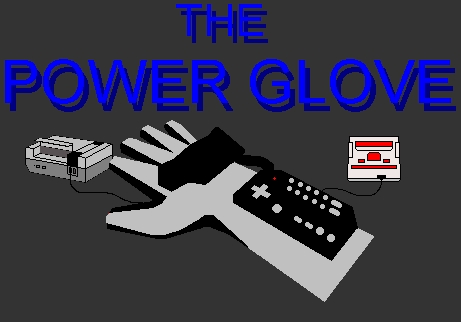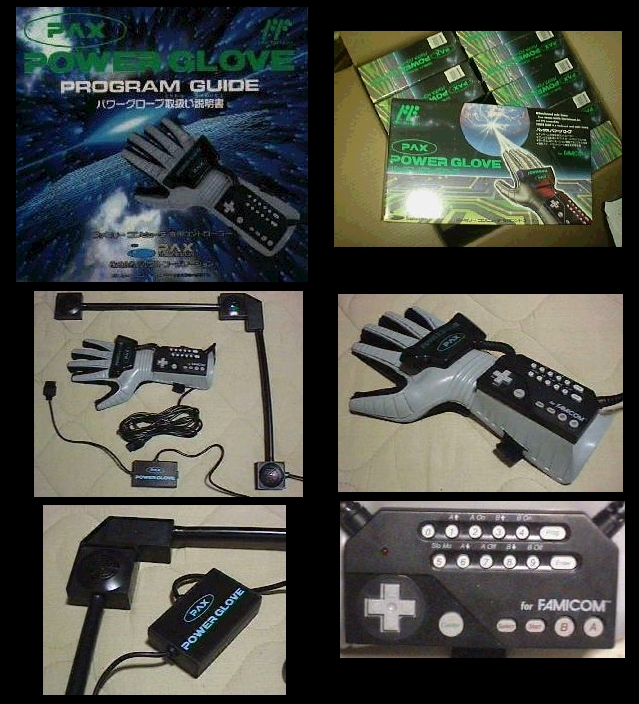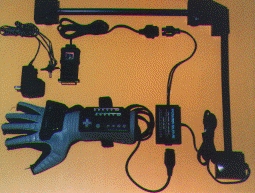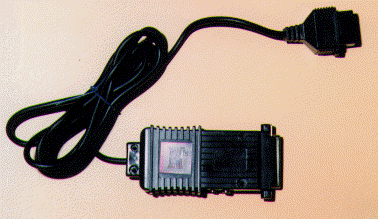
 New Addition! Here is a zip file with all my collected data on the Power Glove. They were spanned over five floppy disks, unfortunately some data was corrupted, and I do not think the instructions for hooking the power glove up to the parallel port is in here. Though there is one for hooking it up to your keyboard port. I used Joe Gradecki’s book for hooking mine up (I suggest you get a copy). I also added a close up pic of the PSI.
New Addition! Here is a zip file with all my collected data on the Power Glove. They were spanned over five floppy disks, unfortunately some data was corrupted, and I do not think the instructions for hooking the power glove up to the parallel port is in here. Though there is one for hooking it up to your keyboard port. I used Joe Gradecki’s book for hooking mine up (I suggest you get a copy). I also added a close up pic of the PSI.
 .
(This Article was originally appeared in
Design News 12-4-89 written by Dana L. Gardner, Associate Editor.
It should give you something to read while the pics load.)
.
.
(This Article was originally appeared in
Design News 12-4-89 written by Dana L. Gardner, Associate Editor.
It should give you something to read while the pics load.)
.
Combine the hottest video game with a $10,000
computer peripheral, shape it into an inexpensive yet futuristic 'glove',
and you've got this year's smash toy.
.
Throw away your joysticks, kids. Punching out
the heavy-weights and zapping alien spaceships on your home video screen
has evolved from two-dimensional wrist-wringing to 3-D arm-swinging. The
Mattel Power Glove has elevated the level of video interaction by an order
of magnitude -- the difference between a toggle switch and a ray gun.
'
In design terms, a versatile, $75 commercial
product--replete with sensors, programmable keypad, and microprocessor--was
quickly gleaned from a $10,000 computer peripheral used by NASA robots
in space. Teams of engineers on both coasts bridged the price and application
gaps so quickly that even the Japanese decided it would take too long to
develop their own.
.
Ever since Japan's Nintendo Entertainment System
and video game cartridges invaded the minds of America's youth a few years
ago, toy designers and inventors have been scrambling to devise the next
generation of electronic games. Abrams Gentile Entertainment Inc. (AGE),
New York, staked its claim on a 3-D peripheral that puts the player through
the actual motions of the game. Rather than beat Nintendo, AGE and Mattel
engineers joined them by relying on the Nintendo system, but adding a better
link between kid and machine.
.
Photo caption: Ultrasonic transmitters on the
top of the Power Glove feed positioning information to the L-bar microphone
on the top of the television (not shown). Triangulation algorithms give
3-D positioning of the glove wearer's hand in relation to the activity
of the figures on the screen. (Stuart Watson photo)
.
A new generation of games
'
"When Nintendo saw the glove, they knew there
was no way to bring together the people to do it themselves," explains
AGE partner and chief engineer Christopher Gentile. "We were flown out
to Japan by a bunch of people who wanted to buy technology from us. It
was a little change of pace, to say the least."
.
Mattel, Nintendo's U.S. distributor, bought the
technological design license from AGE, raced to develop the Power Glove's
appearance by using a California image shop, created enhanced software,
and put on a multi-million dollar advertising blitz. The giant Hawthorne,
CA, toy maker expects to sell a million Power Gloves in the product's first
year. The company has a licensing agreement with Nintendo, but will sell
the gloves as a Mattel product. This holiday gift-buying season will provide
the lion's share of the first-year sales, Mattel marketers predict. Next
summer, new game software will emerge designed specifically for the Power
Glove so that game players can truly become part of the action.
.
Computer firms are also examining whether engineers
and other computer users would benefit from a very similar glove device
to drive and control CAD and other graphics systems.
.
The story behind the Power Glove -- racing to
meet squeaky-tight deadlines, international haggling in the nerves-of-steel
toy business. and searching for innovative technology, software, and appearance
-- could itself be the basis for a lightning-fast action game. By avoiding
the snake pits, wrestling the prize away From the gorilla, and leaving
the jungle first -- the Power Glove designers are on their way to probable
glory and riches.
'
Shopping for a design idea
.
The technology for the Power Glove originated
with high-technology computer peripherals. The leap from keyboard to mouse
created the demand for free-moving, hand-operated interaction devices.
A 3-D ultrasonic pen was developed to move images on a screen. It was followed
in 1986 by the $10,000 Data Glove peripheral by VPL, Inc.
.
The expense of the glove limited its use to such
research and development shops as the MIT Media Lab and NASA Lewis Research
Center, as well as on advanced graphics stations and engineering workstations.
NASA used the sensor-laden glove, for example, to directly command robots.
The robot arm would react in real time to whatever the glove-wearer did
with his or her arm. The glove was also part of simulating complex situations
on super-computers.
.
AGE, seeing the possibility of adapting the Data
Glove technology to video games, bought the license for VPL's initial glove
technology. The firm then went about reducing it to a consumer version
that would direct 3-D commands to a video screen in real time.
.
"The nice thing about the glove, in all applications,
is that -- unlike a mouse or a joystick which you have to learn how to
use -- it's self-contained. The glove knows how you work. You just act
naturally and it automatically translates that into commands," says Gentile.
'
"It's a different animal," says Novak, a Mattel
staff designer, of the glove. "Joysticks are two-dimensionally linear.
Up. Down. Left. Right. When you go to the glove, you get the z-axis, in
and out -- and you can rotate and finger-bend so that each finger becomes
a trigger."
.
Of the 120 Nintendo joystick games, all can be
used with the Power Glove. Users can select their own personal hand gestures
and finger movements to replace the limited movements of a joystick.
.
A new game, "Bad Street Brawler," takes advantage
of the Power Glove's capabilities. The glove wearer actually makes a fist
and punches out at the attacker.
.
"The space in front of the player becomes a space
inside the video tube. We call it the 'virtual playfield,'" says Novak.
"It's kind of freaky when it happens. It's almost like a mirror, but it's
not reversed."
.
Next summer, when the software in the game cartridges
catches up to the hardware and sensing abilities of the glove--the Power
Glove Gaming Series--the player will be able to control much more of the
screen with various hand and arm motions. A handball game with the player
using an open or closed palm to swing at the ball, for example, will be
possible.
`
Photo caption: Gary Yamron, left, and Hal Barger
of Image Design & Marketing review the exterior design of the Power
Glove. Working quickly, they overcame a number of design concerns to effectively
blend form with function.
.
Photo caption: A programmable keypad on the top
of the Power Glove allows the user to tailor hand and finger movements
to former joystick commands, or to enhance a game's play. New game software
next summer will fully utilize the glove's potential.
.
Ways to reduce sensor costs
.
Engineers needed to make the glove a commercial
reality in time for this Christmas. To do so, teams of designers, marketers,
and software and hardware specialists from around the country were united.
Their starting point, the expensive Data Glove, gave them little more than
a template.
.
The Data Glove's sensor technology was expensive
and couldn't be easily mass-produced, both of which presented unique problems
for adaptation to video games. First, Mattel engineers had to find a cheaper
way to gage and communicate the movement of wrist and fingers. The Data
Glove uses optic fibers in the glove's finger sleeves to measure and track
finger-joint movement. As the finger bends the fiber, less and less light
passes through. A photo resistor at the end measures the amount of light
to calculate the angle of the wearer's finger at any given time.
'
A second major hurdle, communicating the 3-D
orientation of the hand in relation to the images on the video screen,
also had to be overcome inexpensively. The high-end Data Glove used a magnetic
sensor that detected the exact position of the glove in a magnetic field
to determine its relation to the computer screen or robot.
.
Ultrasonics provide solution
.
To solve these problems, designers took a step
backward. Remembering that the pen computer peripheral relied on ultrasonics
to move cursors, they began developing an ultrasonic sensor system for
the Power Glove. Three points of reference were needed between the glove
and the television screen so a quick series of triangulation calculations
could be done. The process depended on algorithms and geometry, which required
a microprocessor in the glove, to pinpoint the user's hand position.
.
The designers settled on two ultrasonic transmitters
spaced about 3 inches apart on the glove above the knuckles, and two receivers
on a 1 ft-long "L-bar" placed on the television's top.
.
"Each one of the receivers, or microphones, on
the TV set has its own little stopwatch," explains Gentile. "We throw out
a beep from the transmitters on the glove and clock them. When each of
the microphones receives the signal, it stops the clock. Based upon the
difference in time between when each of the microphones detects the beep,
we use a triangulation formula to determine where the hand is in 3-D space."
.
The ultrasonic system provides a 1/4-inch resolution
at a distance of 5 ft. The digital feedback from the sensors allows the
glove to update its position 30 times a sec. This orientation system proves
sufficient For use with video games. Both the glove and L-bar plug into
the existing joystick socket on the Nintendo game system unit. Power comes
from the joystick socket.
.
Finger bends give commands
.
To attack the problem of sensing finger movement,
Mattel and AGE engineers first sought cheaper materials than fiber optics
and photo resistors. Light sources gave way to conductive properties. They
thought they found a solution, Gentile recalls, in using conductive rubber,
but the rubber didn't return to its prior shape quickly enough. Finally,
they found a conductive ink that was supposed to be used to build flexible
circuit boards.
.
The conductive ink, it turned out, didn't work
well on circuit boards because its conductive properties changed when it
was bent. This detriment to circuit building, however, was exactly what
AGE engineers were looking for: An inexpensive way of calculating movement
-- two layers of the ink became a sensor.
.
With their basic technology in hand, engineers
on both coasts set about, in November 1988, to make the product user-friendly
and manufacturable. Scott Goodman was Mattel's mechanical engineer, Norman
Grannis was the electrical engineer, while Novak worked out software and
game applications for the project. They had until March, or less than five
months, to perfect the design and begin testing and debugging. Then they
could order materials and tool the Hong Kong factory so production would
start in late summer for October distribution to toy stores.
.
"This was a total fire drill," says Gentile of
the AGE team. "We were doing design concepts, software, and hardware design--all
parallel."
.
Capturing a futuristic look
.
While AGE engineers in New York and Mattel staffers
in Southern California were hammering out the choice of sensors, chip design,
and 15 configuration programs in the processor, a third party was called
in. Mattel hired image Design & Marketing, Hermosa Beach, CA, to pull
all the technology together and fashion the Power Glove's makeup and appearance.
Image Design had to allow for a number of design considerations.
.
The glove had to:
'
•Fit many different hand and forearm sizes. •Afford
the user wrist dexterity. •Provide a cord to the joystick port that did
not interfere with vigorous use. •Hold up under various amounts of hand
perspiration. •Be turned on and off easily. •Allow access to change the
programs on the keypad depending on the game and game mode. •Be hazard
free and above claims of product liability. •Look attractive enough to
im-press the toy makers, and the 9- to 14-year-old users.
.
.
.
"The biggest challenge was that we had to house
the sensors, a preexisting component, and we had to do it so that it was
light, yet still allowed a free-form feel of movement," says Hal Berger.
a co-owner of Image Design & Marketing.
.
Berger and his partner, Gary Yamron, decided
on a "Stealth" look for the sensor unit. A slightly curved, manta ray-shaped
component above the knuckles holds the sensors. A short cord connects the
sensors to a key pad on the back of the wrist and forearm, from which the
cord goes to the television-top Nintendo unit. The key pad provides choices
for several operating modes, such as slow motion, and "turbo" For rapid
repeat action.
.
To allow for various hand sizes to fit in the
glove, Berger and Yamron left the fingertips and palm open, made the rest
of the glove out of stretch material, and added a Velcro strap to hold
the glove tight to any number of users. But the glove still comes in two
sizes.
'
The top of the glove is plastic and sports the
futuristic appearance. The team used an IBM PC and Auto CAD software to
design the glove's appearance.
.
Image Design & Marketing, which is designing
the futuristic look of some set components for the new film Robocop II,
designed the first Power Glove prototype six days after the concept was
developed, says Yamron.
.
Glove points to the future
'
As the Power Glove gains recognition and finds
itself in more living rooms across the country, other applications are
gaining momentum. AGE in New York has already fielded inquiries from Cornell
University and Auto CAD-maker Autodesk Inc., Saulsalito, CA about designing
a slightly better, more expensive glove for CAD use.
.
"Our next step with our glove," says AGE's Gentile,
"is to produce a 'mouse glove' For general-purpose computers. The advantage
is that you can do 3-D work, multiple tasking, and CAD becomes very easy."
.
In a unique twist of technology, space-age application
has spawned a consumer-level product, which may lead to a industrial-level
tool to help engineers make other products.
.
'
TIME LINE FOR DESIGN
.
.
1985
.
Video game market explodes. Way sought to compete
with Japanese products.
.
1986
'
VPL, Inc. develops Data Glove for NASA and supercomputer
use.
.
1987
.
AGE, Inc. buys VPL license to develop consumer
version of Data Glove for video games.
.
1988
.
AGE gains support and sells license to Mattel,
Inc. to develop Power Glove.
'
1988
'
Teams of engineers and designers hammer out a
Power Glove prototype in five months.
.
1989
.
Debugging and tooling allow glove to go into
production for world-wide distribution for Christmas shopping season.
.

 THIS IS AN ORIGINAL POSTER FOR THE POWER
GLOVE BEFORE ITS RELEASE.
THIS IS AN ORIGINAL POSTER FOR THE POWER
GLOVE BEFORE ITS RELEASE.
 The Power Glove in Japan was made by a company called
PAX. The too types of Power Gloves are basically the same with minor differences.
The Power Glove in Japan was made by a company called
PAX. The too types of Power Gloves are basically the same with minor differences.

 When Hackers got there hands on the Power Glove they
new just what to do with it... find a way to interface it with a computer.
When it was finally hacked in late 1990 or early '91 (I can't remember
which) the news was spread over the phone lines to every body who was listening.
Back then everything was either text or programing not like the internet
is today, but it was still great for passing info along. Well many things
were done with it once it got hacked, it could be used with word processors
with out need of a key board, or as a mouse, Mark Trayle (inventor of VR
and first computer glove) made a special copy of his "Air Guitar" program
just for use with the Power Glove. Though these were fun things to
use it with none was probably more astounding than REND386, a 3-D polygon
rendering package for the 386 and 486 written by Dave Stampe and Bernie
Roehl. It was VR for any one who wanted it and it was free! REND386 had
codes in it for total use with the Power Glove and other input and output
devices like the Sega 3-D Shutter Glasses. Plus if you had a CAD program
you could use it to easily make 3-D objects for your own virtual world!
After working with Bernie Roehl on five different versions of REND386 Dave
Stampe went on to make VR-386 it was like REND386 but better. With about
90% of the old codes rewritten VR-386 had the fastest drawing speed of
any VR software in its class, exceeding 20,000 polygons per second. Basically
VR-386 supports most of the features in REND386 (version 5), and adds new
features. Unfortunately I haven't heard any thing about Bernie Roehl's
progress. If you're out there Bernie give
me a call! :)
.
When Hackers got there hands on the Power Glove they
new just what to do with it... find a way to interface it with a computer.
When it was finally hacked in late 1990 or early '91 (I can't remember
which) the news was spread over the phone lines to every body who was listening.
Back then everything was either text or programing not like the internet
is today, but it was still great for passing info along. Well many things
were done with it once it got hacked, it could be used with word processors
with out need of a key board, or as a mouse, Mark Trayle (inventor of VR
and first computer glove) made a special copy of his "Air Guitar" program
just for use with the Power Glove. Though these were fun things to
use it with none was probably more astounding than REND386, a 3-D polygon
rendering package for the 386 and 486 written by Dave Stampe and Bernie
Roehl. It was VR for any one who wanted it and it was free! REND386 had
codes in it for total use with the Power Glove and other input and output
devices like the Sega 3-D Shutter Glasses. Plus if you had a CAD program
you could use it to easily make 3-D objects for your own virtual world!
After working with Bernie Roehl on five different versions of REND386 Dave
Stampe went on to make VR-386 it was like REND386 but better. With about
90% of the old codes rewritten VR-386 had the fastest drawing speed of
any VR software in its class, exceeding 20,000 polygons per second. Basically
VR-386 supports most of the features in REND386 (version 5), and adds new
features. Unfortunately I haven't heard any thing about Bernie Roehl's
progress. If you're out there Bernie give
me a call! :)
.
 HERE WE HAVE THE HACKED POWER GLOVE AND
3-D SHUTTER GLASSES, PROBABLY BEING USED WITH REND386.
.
HERE WE HAVE THE HACKED POWER GLOVE AND
3-D SHUTTER GLASSES, PROBABLY BEING USED WITH REND386.
.
Eventually an input devise called PSI came out
so you didn't have to chop up your Power Glove and not be bothered with
all the work of making a Shutter Glasses input. I had already chopped up
one of my Power Gloves but didn't want to make an interface for the Shutter
Glasses. I think you can still get the PSI from PCVR Magazine, e-mail them
at : PCVR@FULLFEED.COM
.

 THE PSI WITH THE AC ADAPTER.
.
THE PSI WITH THE AC ADAPTER.
.
The book "The Virtual Reality Construction Kit"
written in 1994 by Joe Gradecki had a COMPLETE coverage of the Power Glove
including the equations on the way it worked. In this book there is tons
of info on building your own VR equipment for pennies, and making worlds.
Not only that but it also comes with a disk. It's a must read book! Dave
Stampe and Bernie Roehl also wrote a book "Virtual Reality Creations",
published by Waite Group Press.
'
 For five or more years AGE has been involved in the
continued research and exploitation of Virtual Reality. The "Power Glove"
a revolutionary video game control was licensed to Mattel who marketed
it for use with the Nintendo Entertainment System in 1989. The Power Glove
which was the first Virtual Reality product to be produced for the consumer
market has grossed over $80 million dollars to date worldwide. The success
of the Power Glove has made it part of the pop video culture and has been
showcased in such major motion pictures as the Universal Film The Wizard
starring Fred Savage and more recently Freddy's Dead, Nightmare On Elm
Street, All I Want For Christmas, and Sliver. Due to the large demand for
Power Gloves from the computer industry, AGE was going to release, in 1997,
the PC Power Glove. This computer peripheral, is specifically designed
for the PC industry for use in areas of computer gaming, scientific visualization
and computer design. Unfortunately no one knows what happened to this plan
and I never got a response from the e-mail e-mail I sent them.
.
For five or more years AGE has been involved in the
continued research and exploitation of Virtual Reality. The "Power Glove"
a revolutionary video game control was licensed to Mattel who marketed
it for use with the Nintendo Entertainment System in 1989. The Power Glove
which was the first Virtual Reality product to be produced for the consumer
market has grossed over $80 million dollars to date worldwide. The success
of the Power Glove has made it part of the pop video culture and has been
showcased in such major motion pictures as the Universal Film The Wizard
starring Fred Savage and more recently Freddy's Dead, Nightmare On Elm
Street, All I Want For Christmas, and Sliver. Due to the large demand for
Power Gloves from the computer industry, AGE was going to release, in 1997,
the PC Power Glove. This computer peripheral, is specifically designed
for the PC industry for use in areas of computer gaming, scientific visualization
and computer design. Unfortunately no one knows what happened to this plan
and I never got a response from the e-mail e-mail I sent them.
.
 .
'
©1998-2004
.
'
.
'
©1998-2004
.
'
 .
'
.
'
.
'
.
'
.
'
.
'
.
'
.
'




